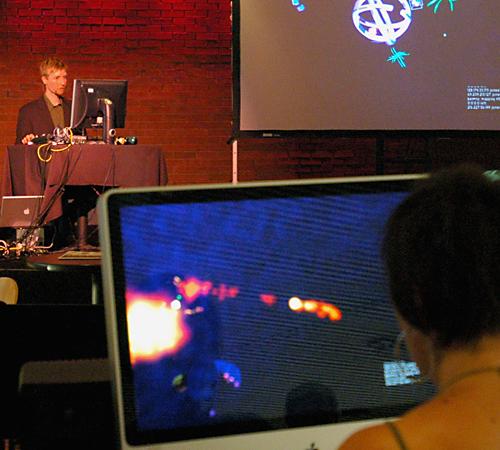Inside the nexus of notes

en Smith, graduate student, explains to viewers how his newly invented computer game works at the Krannert Center on Friday Erica Magda
Sep 26, 2007
Last updated on May 12, 2016 at 04:23 p.m.
Bright, abstract objects fly at random across the black expanse of nothingness as a unique cluster of sounds radiate all around. Beyond what can be seen by the naked eye, it may seem as though this is a scene from our universe, yet there is something fantastical about it at the same time.
This is not just any universe, it is the “MusiVerse,” a concept created by graduate student Ben Smith. The event was held for the first time at the Krannert Center for the Performing Arts, 500 S. Goodwin Ave.
The “MusiVerse” is a computer game, an interface for people to log in and interact through the creation of different sounds and objects.
“I had this dream,” said Smith, “that I held this ball in my hand and this ball, because I want it to, it makes music and sings. Now I get another ball, and because they are related to each other, they start to move toward each other. As they move closer, they realize their relationship is changing, and they start playing different music. Then, they are going to bounce off each other, and who knows what’s going to happen.”
Get The Daily Illini in your inbox!
The “magic” of the “MusiVerse,” is that it is its own entity, intricately interwoven with music and objects, pushing the boundaries between what is real and what is abstract.
Guy Garnett, associate professor of music composition, said that the “MusiVerse” is the first in a whole new genre of possibilities.
“We have created a virtual world,” Garnett said. “A universe, rather a ‘MusiVerse,’ because everything in it has musical implications.”
Each player is a member of the same “MusiVerse,” or network, logged into the same server and can interact with one another via chat and sound.
“The interaction is through the creation of the objects with the sounds attached,” Smith said. “They influence the musical rendering of each object.”
Adva Steiner, academic adviser in general studies, was intrigued by the brief invitation she received to attend the performance.
“I knew nothing about it,” Steiner said. “I think they did it on purpose, to keep it kind of a mystery. It is pretty abstract.”
The odd nature of this concept has left some audience members in the dark, but Garnett said he was quick to try and clear up any confusion.
“This is a completely new kind of art form,” Garnett said. “We are trying to explore different artistic expressions and trying to extend it in a variety of ways. The virtual world has a capability that we can explore in any number of ways.”
Inspiration for this concept came to Smith by way of his longing to join several different interests, while still appealing to younger generations.
“I started exploring bringing music into video game spaces,” Smith said. “We are all used to having music in video games, but it is just a prerecorded sound track. They are getting better about making the music change in response to your actions in the game, but the response isn’t immediate and it’s not something you have control over. I wanted to make something that was both like a musical instrument and a video game.”
This particular virtual environment had eight players, logged in from computer systems around the room and across the country. Combined, they sought to manipulate the world and create unique visuals, Smith said.
Each computer had a different view, and was producing a unique compilation of sounds and objects. This concept, dubbed “MusiVerse,” is so new that the edges are still unclear, and is something that Smith plans to research further, and eventually expand into his doctoral thesis.
Today, Smith sees “MusiVerse” as just a “play” environment, but hopes to develop it into something greater, one day.
“I would be really excited if I could make it available for anyone to log into,” Smith said. “Where people would meet up, chat, and make music. It would be a dream.”
Look for another performance of the “MusiVerse” next semester at Krannert Art Museum, 500 E. Peabody Drive; no further details have been announced.





